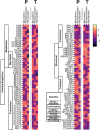Cancer and Associated Therapies Impact the Skeletal Muscle Proteome
- PMID: 35694399
- PMCID: PMC9184684
- DOI: 10.3389/fphys.2022.879263
Cancer and Associated Therapies Impact the Skeletal Muscle Proteome
Abstract
Introduction: Both cancer and cancer associated therapies (CAT; including chemotherapy or concurrent chemoradiation) disrupt cellular metabolism throughout the body, including the regulation of skeletal muscle mass and function. Adjunct testosterone therapy during standard of care chemotherapy and chemoradiation modulates CAT-induced dysregulation of skeletal muscle metabolism and protects lean body mass during CAT. However, the extent to which the skeletal muscle proteome is altered under these therapeutic conditions is unknown. Objective: We probed the skeletal muscle proteome of cancer patients as an ancillary analysis following a randomized, double-blind, placebo-controlled phase II trial investigating the effect of adjunct testosterone on body composition in men and women with advanced cancers undergoing CAT. Methods: Men and women diagnosed with late stage (≥IIB) or recurrent head and neck or cervical cancer who were scheduled to receive standard of care CAT were administered an adjunct 7 weeks treatment of weekly intramuscular injections of either 100 mg testosterone (CAT+T, n = 7; 2M/5F) or placebo/saline (CAT+P, n = 6; 4M/2F). Biopsies were performed on the vastus lateralis before (PRE) and after (POST) the 7 weeks treatment. Extracted proteins were separated with 2-dimensional gel electrophoresis (2DE), and subjected to analyses of total protein abundance, phosphorylation and S-nitrosylation. Proteoforms showing significant 1.5 fold differences (t-test p ≤ 0.05) between PRE and POST timepoints were identified by mass spectroscopy (MS), and lists of altered proteins were subjected to Gene Set Enrichment Analysis (GSEA) to identify affected pathways. Results: A total of 756 distinct protein spots were identified. Of those spots, 102 were found to be altered in terms of abundance, phosphorylation, or S-nitrosylation, and identified by mass spectroscopy analysis to represent 58 unique proteins. Among the biological processes and pathways identified, CAT+P predominantly impacted metabolic processes, cell assembly, oxygen transport, and apoptotic signaling, while CAT+T impacted transcription regulation, muscle differentiation, muscle development, and contraction. Conclusion: Cancer and CAT significantly altered the skeletal muscle proteome in a manner suggestive of loss of structural integrity, reduced contractile function, and disrupted metabolism. Proteomic analysis suggests that the addition of adjunct testosterone minimized the structural and contractile influence of cancer and its associated therapies.
Keywords: atrophy; cachexia; nitrosylation; phosphorylation; post-translational modifications; proteome; testosterone.
Copyright © 2022 E. L., T. J., A. R., A. B., K. M., C. P., C. R., J. E., K. V., R. J. and M.
Conflict of interest statement
The authors declare that the research was conducted in the absence of any commercial or financial relationships that could be construed as a potential conflict of interest.
Figures


References
LinkOut - more resources
Full Text Sources
Miscellaneous

